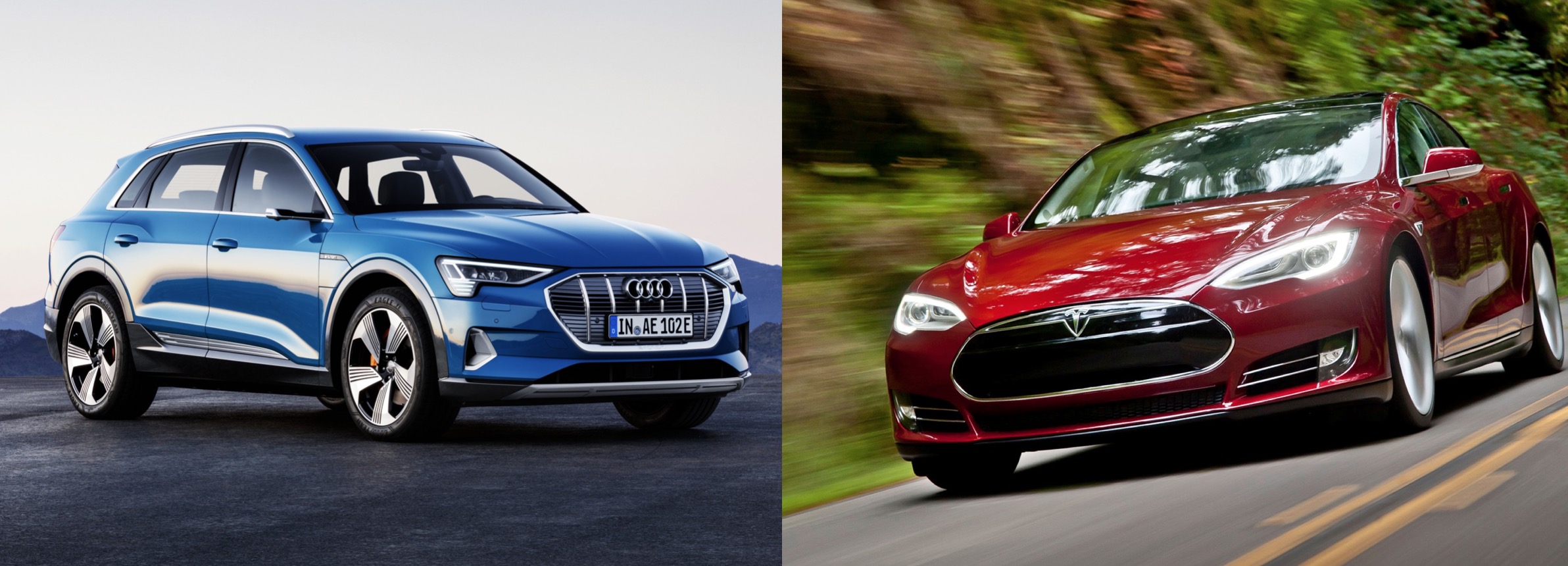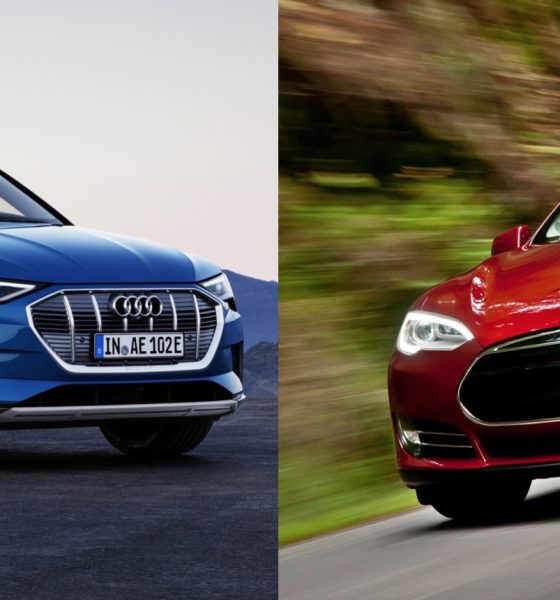

News
‘Tesla killers’ are celebrating 7-year anniversary since Model S debut
This is a free excerpt of our weekly members-only newsletter. Each week, we give you our take on the biggest stories of the week, our favorite photos & videos and much more. Become a member today receive all of Teslarati’s newsletters.
In just a few weeks, Tesla’s first mass-produced vehicle (Model S) will be celebrating 7 years on the road. Back in June 2012, people would scoff when you would mention Tesla, “Who’s going to buy an electric car, let alone a luxury electric car??”
A lot has changed since then. The company has sold over 260,000 Model S’ globally since its debut and it has yet to be dethroned as the longest-range electric vehicle on the road. After analysts and naysayers starting paying attention to Tesla in late 2012 (hint: Model S was Motor Trend Car of the Year in 2012), another narrative took shape, The Germans will squash these California guys, just wait a few years.
So here we are, 7 years later. Audi has just released its first real EV, the e-tron, and Mercedes is in the process of launching their counterpart, the EQC, BMW is nowhere to be found. While the e-tron and the EQC are meaningful ploys to keep Audi and Mercedes customers from fleeing to Tesla, they seem underwhelming and late. The e-tron is equipped with a massive 95 kWh battery, but only erks out 204-miles of EPA range, and the EQC is estimated to land somewhere in between 200-220 miles with an 80 kWh battery.

Let’s be clear, no one is a bigger fan of automakers entering the EV space. Audi’s e-tron should be considered an overture for the upcoming Audi and Porsche co-developed electric vehicles, which will sport one of the first 800V systems, longer range, and more efficient motors. But one thing is clear here, Tesla is still miles and years ahead of the Germans. Porsche’s upcoming Taycan would have been quite competitive with the 2018 Model S, but with the Model S’s latest platform update sporting 370-miles out of a 100 kWh battery, Tesla’s lead becomes more and more apparent. Things haven’t panned out as 2013 wall street envisioned.
Batteries, Motors, Capacity, and more!
Tesla’s latest range increases are certainly impressive, but it’s important to know where these increases are coming from: motor technology. Tesla has been developing their own motors for 15 years and has a massive lead on existing OEMs and suppliers. From the outside, Tesla’s famed Gigafactory with Panasonic makes it appear as though their battery-cells are the secret sauce, but battery suppliers have been working on lithium-ion technology far longer than Tesla. To find where Tesla is truly leading with battery technology turn to the company’s thermal management systems and packaging of the cells. While Tesla’s cells aren’t the most exciting things on earth (modified-2170 cells), their early investment into production capabilities has allowed them to lower costs and scale battery production in conjunction with vehicle demand.
Tesla’s been ahead of the game since the start and is positioned to stay ahead for many years. Do you think the German automakers or others will ever catch up to Tesla? If so, when and who? Let me know in the comments.

News
Tesla FSD fleet is nearing 7 billion total miles, including 2.5 billion city miles
As can be seen on Tesla’s official FSD webpage, vehicles equipped with the system have now navigated over 6.99 billion miles.

Tesla’s Full Self-Driving (Supervised) fleet is closing in on almost 7 billion total miles driven, as per data posted by the company on its official FSD webpage.
These figures hint at the massive scale of data fueling Tesla’s rapid FSD improvements, which have been quite notable as of late.
FSD mileage milestones
As can be seen on Tesla’s official FSD webpage, vehicles equipped with the system have now navigated over 6.99 billion miles. Tesla owner and avid FSD tester Whole Mars Catalog also shared a screenshot indicating that from the nearly 7 billion miles traveled by the FSD fleet, more than 2.5 billion miles were driven inside cities.
City miles are particularly valuable for complex urban scenarios like unprotected turns, pedestrian interactions, and traffic lights. This is also the difference-maker for FSD, as only complex solutions, such as Waymo’s self-driving taxis, operate similarly on inner-city streets. And even then, incidents such as the San Francisco blackouts have proven challenging for sensor-rich vehicles like Waymos.
Tesla’s data edge
Tesla has a number of advantages in the autonomous vehicle sector, one of which is the size of its fleet and the number of vehicles training FSD on real-world roads. Tesla’s nearly 7 billion FSD miles then allow the company to roll out updates that make its vehicles behave like they are being driven by experienced drivers, even if they are operating on their own.
So notable are Tesla’s improvements to FSD that NVIDIA Director of Robotics Jim Fan, after experiencing FSD v14, noted that the system is the first AI that passes what he described as a “Physical Turing Test.”
“Despite knowing exactly how robot learning works, I still find it magical watching the steering wheel turn by itself. First it feels surreal, next it becomes routine. Then, like the smartphone, taking it away actively hurts. This is how humanity gets rewired and glued to god-like technologies,” Fan wrote in a post on X.
News
Tesla starts showing how FSD will change lives in Europe
Local officials tested the system on narrow country roads and were impressed by FSD’s smooth, human-like driving, with some calling the service a game-changer for everyday life in areas that are far from urban centers.

Tesla has launched Europe’s first public shuttle service using Full Self-Driving (Supervised) in the rural Eifelkreis Bitburg-Prüm region of Germany, demonstrating how the technology can restore independence and mobility for people who struggle with limited transport options.
Local officials tested the system on narrow country roads and were impressed by FSD’s smooth, human-like driving, with some calling the service a game-changer for everyday life in areas that are far from urban centers.
Officials see real impact on rural residents
Arzfeld Mayor Johannes Kuhl and District Administrator Andreas Kruppert personally tested the Tesla shuttle service. This allowed them to see just how well FSD navigated winding lanes and rural roads confidently. Kruppert said, “Autonomous driving sounds like science fiction to many, but we simply see here that it works totally well in rural regions too.” Kuhl, for his part, also noted that FSD “feels like a very experienced driver.”
The pilot complements the area’s “Citizen Bus” program, which provides on-demand rides for elderly residents who can no longer drive themselves. Tesla Europe shared a video of a demonstration of the service, highlighting how FSD gives people their freedom back, even in places where public transport is not as prevalent.
What the Ministry for Economic Affairs and Transport says
Rhineland-Palatinate’s Minister Daniela Schmitt supported the project, praising the collaboration that made this “first of its kind in Europe” possible. As per the ministry, the rural rollout for the service shows FSD’s potential beyond major cities, and it delivers tangible benefits like grocery runs, doctor visits, and social connections for isolated residents.
“Reliable and flexible mobility is especially vital in rural areas. With the launch of a shuttle service using self-driving vehicles (FSD supervised) by Tesla in the Eifelkreis Bitburg-Prüm, an innovative pilot project is now getting underway that complements local community bus services. It is the first project of its kind in Europe.
“The result is a real gain for rural mobility: greater accessibility, more flexibility and tangible benefits for everyday life. A strong signal for innovation, cooperation and future-oriented mobility beyond urban centers,” the ministry wrote in a LinkedIn post.
News
Tesla China quietly posts Robotaxi-related job listing
Tesla China is currently seeking a Low Voltage Electrical Engineer to work on circuit board design for the company’s autonomous vehicles.

Tesla has posted a new job listing in Shanghai explicitly tied to its Robotaxi program, fueling speculation that the company is preparing to launch its dedicated autonomous ride-hailing service in China.
As noted in the listing, Tesla China is currently seeking a Low Voltage Electrical Engineer to work on circuit board design for the company’s autonomous vehicles.
Robotaxi-specific role
The listing, which was shared on social media platform X by industry watcher @tslaming, suggested that Tesla China is looking to fill the role urgently. The job listing itself specifically mentions that the person hired for the role will be working on the Low Voltage Hardware team, which would design the circuit boards that would serve as the nervous system of the Robotaxi.
Key tasks for the role, as indicated in the job listing, include collaboration with PCB layout, firmware, mechanical, program management, and validation teams, among other responsibilities. The role is based in Shanghai.
China Robotaxi launch
China represents a massive potential market for robotaxis, with its dense urban centers and supportive policies in select cities. Tesla has limited permission to roll out FSD in the country, though despite this, its vehicles have been hailed as among the best in the market when it comes to autonomous features. So far, at least, it appears that China supports Tesla’s FSD and Robotaxi rollout.
This was hinted at in November, when Tesla brought the Cybercab to the 8th China International Import Expo (CIIE) in Shanghai, marking the first time that the autonomous two-seater was brought to the Asia-Pacific region. The vehicle, despite not having a release date in China, received a significant amount of interest among the event’s attendees.









